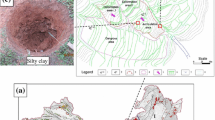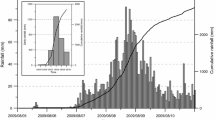Abstract
For the assessment of shallow landslides triggered by rainfall, the physically based model coupling the infinite slope stability analysis with the hydrological modeling in nearly saturated soil has commonly been used due to its simplicity. However, in that model the rainfall infiltration in unsaturated soil could not be reliably simulated because a linear diffusion-type Richards’ equation rather than the complete Richards’ equation was used. In addition, the effect of matric suction on the shear strength of soil was not actually considered. Therefore, except the shallow landslide in saturated soil due to groundwater table rise, the shallow landslide induced by the loss in unsaturated shear strength due to the dissipation of matric suction could not be reliably assessed. In this study, a physically based model capable of assessing shallow landslides in variably saturated soils is developed by adopting the complete Richards’ equation with the effect of slope angle in the rainfall infiltration modeling and using the extended Mohr–Coulomb failure criterion to describe the unsaturated shear strength in the soil failure modeling. The influence of rainfall intensity and duration on shallow landslide is investigated using the developed model. The result shows that the rainfall intensity and duration seem to have similar influence on shallow landslides respectively triggered by the increase of positive pore water pressure in saturated soil and induced by the dissipation of matric suction in unsaturated soil. The rainfall duration threshold decreases with the increase in rainfall intensity, but remains constant for large rainfall intensity.










Similar content being viewed by others
Abbreviations
- C :
-
the change in volumetric water content per unit change in pressure head
- C 0 :
-
the minimum value of C
- c′:
-
effective cohesion
- D 0 :
-
\({K_{s}} \mathord{\left/{\vphantom {{K_{s}} {C_{0}}}} \right.\kern-\nulldelimiterspace} {C_{0}}\)
- d Z :
-
water depth
- d LZ :
-
slope depth
- FS:
-
factor of safety
- I Z :
-
rainfall intensity
- K s :
-
saturated hydraulic conductivity
- K L :
-
hydraulic conductivity in lateral direction (x and y)
- K z :
-
hydraulic conductivities in slope–normal direction (z)
- S :
-
the degree of saturation
- M :
-
fitting parameter
- N :
-
fitting parameter
- T :
-
rainfall duration
- u a :
-
pore air pressure
- u w :
-
pore water pressure
- Z :
-
the coordinates
- σ:
-
total normal stress
- ψ:
-
groundwater pressure head
- θ:
-
soil volumetric water content
- θs :
-
saturated moisture content
- θr :
-
residual moisture content
- α:
-
slope angle
- ϕ′:
-
effective friction angle
- ϕb :
-
the friction ϕ angle with respect to the matric suction
- ζ:
-
fitting parameter
- γ:
-
the unit weight of soil
- γw :
-
the unit weight of water
References
Anderson MG, Howes S (1985) Development of application of a combined soil water-slope stability model. Q J Eng Geol London 18:225–236
Baum RL, Savage WZ, Godt JW (2002) TRIGRS—a Fortran program for transient rainfall infiltration and grid-based regional slope-stability analysis, Virginia, US Geological Survey Open file report 02–424
Bear J (1972) Dynamics of fluids in porous media. Dover, Mineola
Borga M, Fontana GD, De Ros D, Marchi L (1998) Shallow landslide hazard assessment using a physically based model and digital elevation data. Environm Geol 35:81–88
Collins BD, Znidarcic D (2004) Stability analyses of rainfall induced landslides. J Geotech Geoenviron Eng 130(4):362–372
Crosta GB, Frattini P (2003) Distributed modeling of shallow landslides triggered by intense rainfall. Nat Haz Earth Syst Sci 3:81–93
D’Odorico P, Fagherazzi S, Rigon R (2005) Potential for landsliding: dependence on hyetograph characteristics. J Geophys Res Earth Surf 110(F1)
Escario V, Saez J (1986) The shear strength of partly saturated soils. Geotechnique 36:453–456
Frattini P, Crosta GB, Fusi N, Negro PD (2004) Shallow landslides in pyroclastic soil: a distributed modeling approach for hazard assessment. Eng Geol 73:277–295
Fredlund DG, Morgenstern NR, Widger RA (1978) The shear strength of unsaturated soils. Can Geotech J 15:313–321
Hills RG, Hudson DB, Wierenga DB (1989) Modeling one-dimensional infiltration into very dry soils 1. Model development and evaluation. Water Resour Res 25:1259–1269
Hsu SH, Ni CF, Hung PF (2002) Assessment of three infiltration formulas based on model fitting on Richards’ equation. J Hydrol Eng 7(5):373–379
Hurley DG, Pantelis G (1985) Unsaturated and saturated flow through a thin porous layer on a hillslope. Water Resour Res 21:821–824
Iverson RM (2000) Landslide triggering by rain infiltration. Water Resour Res 36:1897–1910
Keim RF, Skaugset AE (2003) Modelling effects of forest canopies on slope stability. Hydrol Process 17:1457–1467
Lan HX, Lee CF, Zhou CH, Martin CD (2005) Dynamic characteristics analysis of shallow landslides in response to rainfall event using GIS. Environ Geol 47:254–267
Montgomery DR, Dietrich WE (1994) A physically based model for the topographic control on shallow landslide. Water Resour Res 30:83–92
Morrissey MM, Wieczorek GF, Morgan BA (2001) A comparative analysis of hazard models for predicting debris flows in Madison County, Virginia. US Geological Survey Open file report 01–67
Richards LA (1931) Capillary conduction of liquids in porous mediums. Physics 1:318–333
Tarantino A, Bosco G (2000) Role of soil suction in understanding the triggering mechanisms of flow slides associated with rainfall. In: Wieczorek GF, Naeser ND (eds) Debris-flow hazards mitigation: mechanics, prediction, and assessment, pp 81–88
Tsai TL (2007) The influence of rainstorm pattern on shallow landslide. Environ Geol (in press)
Tsai TL, Yang JC (2006) Modeling of rainfall-triggered shallow landslide. Environ Geol 50(4):525–534
Van Genuchten (1980) A closed-form equation for predicting hydraulic conductivity of unsaturated soils. Soil Sci Soc Am J 44:892–898
Wallach R, Grigorin G, Rivlin J (1997) The errors in surface runoff prediction by neglecting the relationship between infiltration rate and overland flow depth. J Hydrol 200:243–259
Wu W, Slide RC (1995) A distributed slope stability model for steep forested basins. Water Resour Res 31:2097–2110
Author information
Authors and Affiliations
Corresponding author
Rights and permissions
About this article
Cite this article
Tsai, TL., Chen, HE. & Yang, JC. Numerical modeling of rainstorm-induced shallow landslides in saturated and unsaturated soils. Environ Geol 55, 1269–1277 (2008). https://doi.org/10.1007/s00254-007-1075-1
Received:
Accepted:
Published:
Issue Date:
DOI: https://doi.org/10.1007/s00254-007-1075-1




